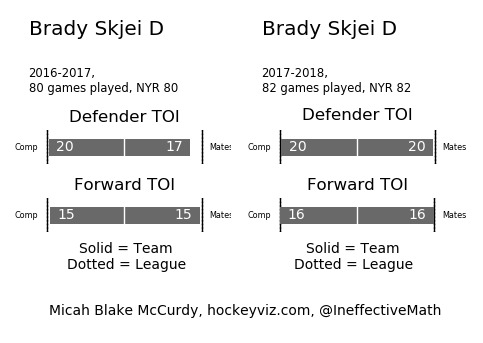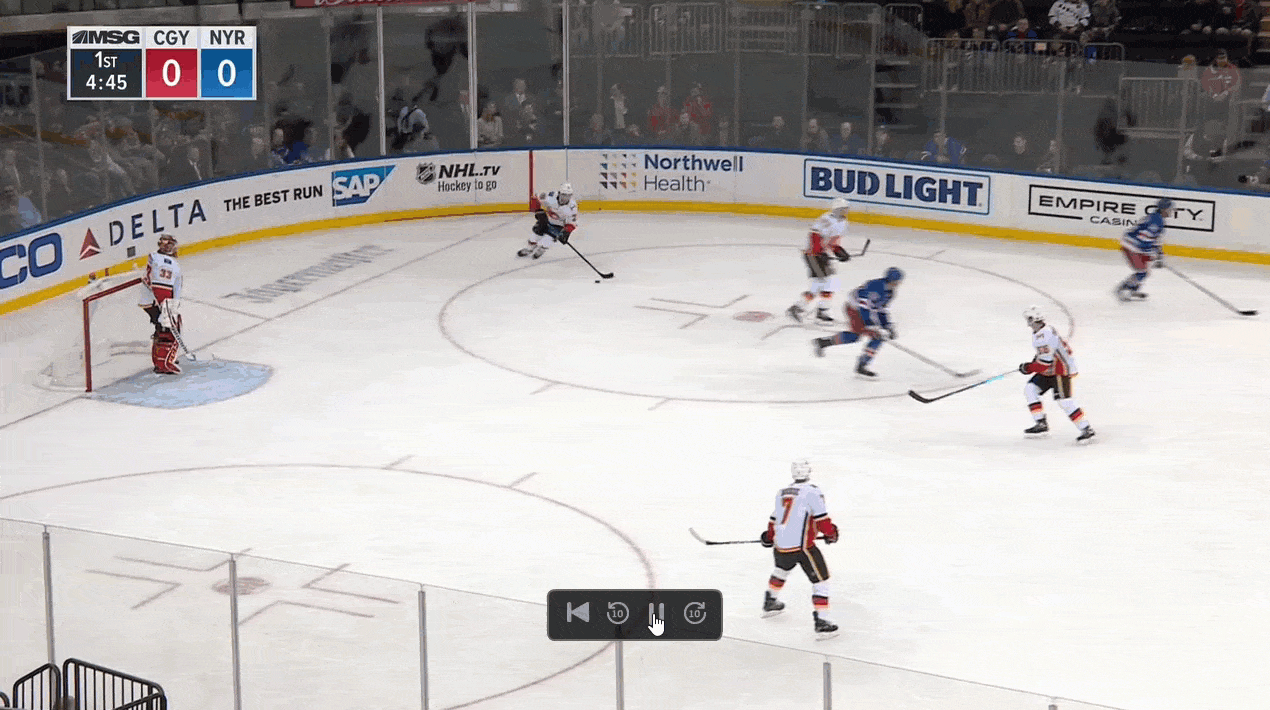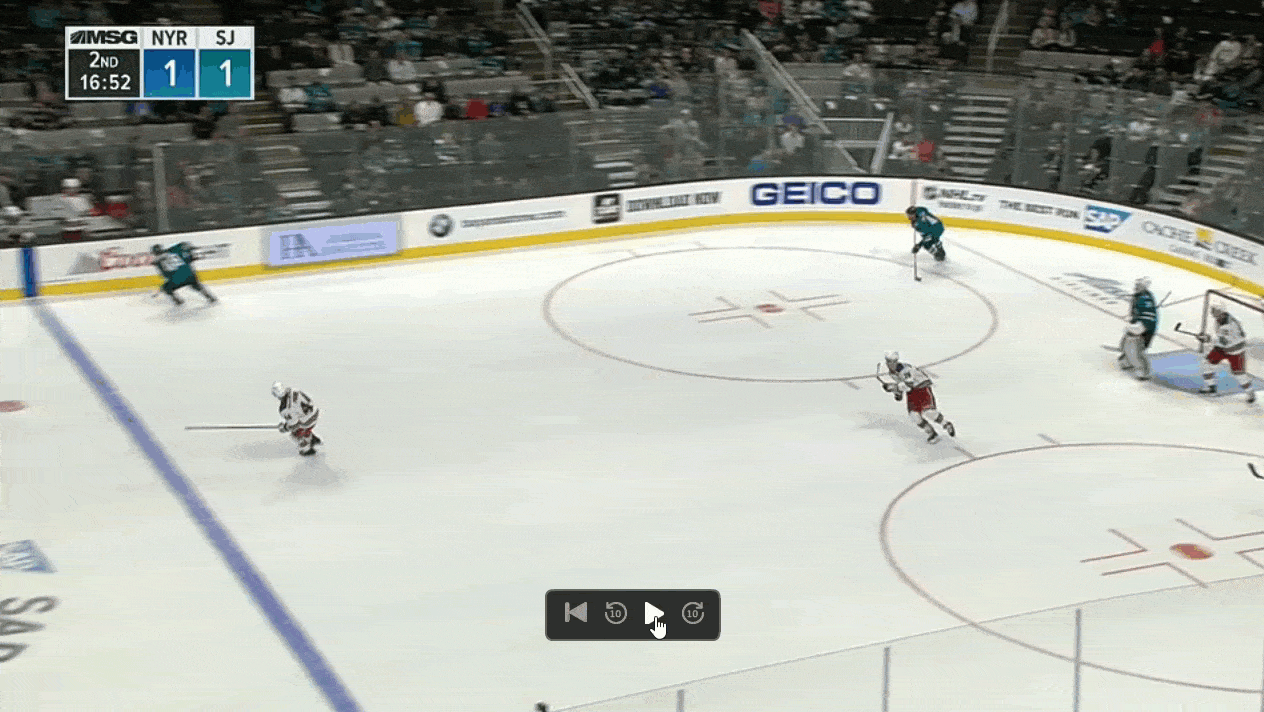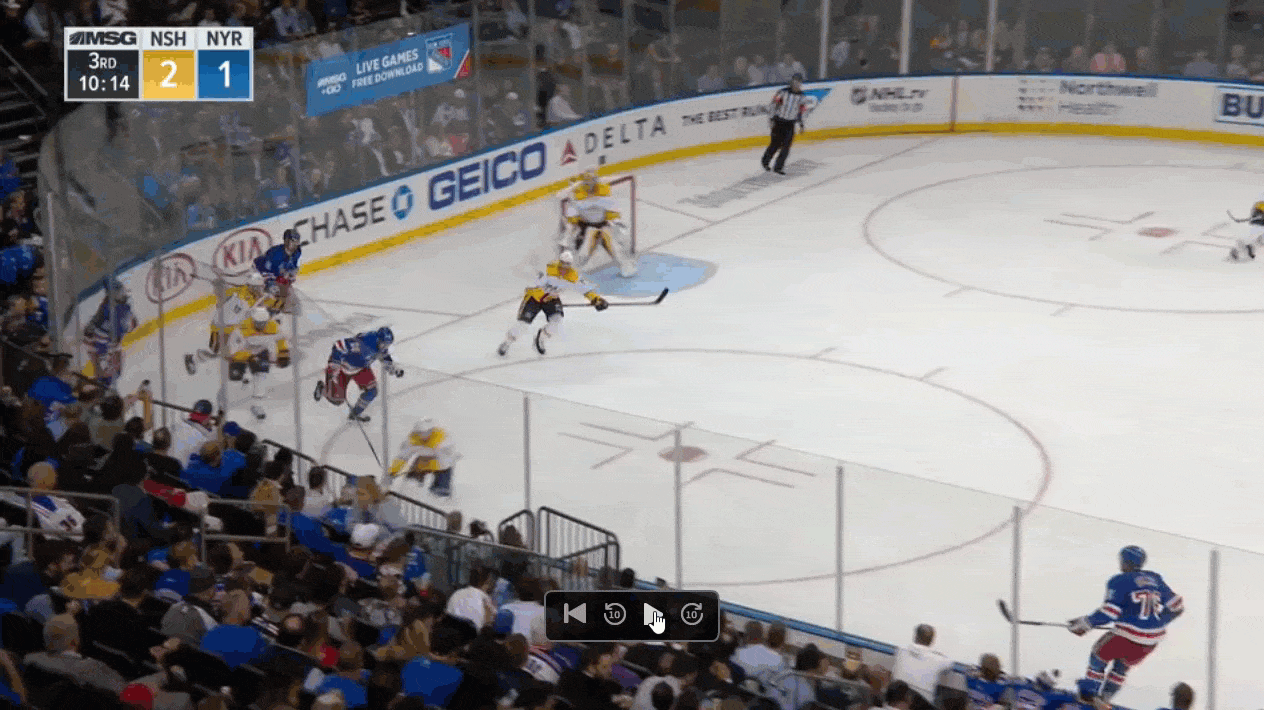Defending zone entries matters. The key research on this is getting somewhat old now, but controlled zone entries should lead to about twice as many unblocked shots as uncontrolled zone entries, preventing controlled zone entries has been shown to be a repeatable skill, and there is a direct relationship between reducing controlled entries against and improving expected goals.
Brady Skjei entered this season with a rich new contract, and was penciled in as a top pairing defenseman.
chart and data from @IneffectiveMath, hockeyviz.com
Two things to note from this HockeyViz graphic [support Micah here]. In Skjei’s first full season (2016/17), he mostly played 3rd pairing minutes, but moved up the depth chart as the season progressed. This progression continued last season (2017/18), and he ended the year as a 1st pairing defenseman.
Thanks to Corey Sznajder, the incomparable @ShutdownLine (subscribe to his Patreon, and who was super helpful to me in writing this), we have very granular data on how players perform in all zones. Luckily for us, the Rangers are one of the teams he’s tracked the most, starting with the 2016/17 season. Let’s look at how Skjei measures up on zone entry defense, specifically.
data from @ShutdownLine, viz by @CJTDevil
Skjei’s 2016/17 is on the left, and 2017/18 is on the right. As you can see, at the time the viz was last updated, Corey had tracked 79 games in 2016/17, and 34 in 2017/18. However, don’t let the lower number of games from last year fool you. According to Corey, it only takes about 10 games before these zone data results stabilize. These are rate stats, which attempt to compare apples to apples, and compensate for the fact that not every player has the same time on ice.
Breakups /60: How many times did Skjei disrupt an opponent’s entry attempt, in an average 60-minutes of ice time?
Possession Entries Allowed /60: How many possession entries did Skjei allow, in an average 60-minutes of ice time?
Possession Entry % Allowed: What percentage of all entry attempts against Skjei were successful possession entries, in an average 60-minutes of ice time?
Finally, the numbers shown in the charts are percentiles, not raw figures. So in 2016/17, Skjei’s “Breakups/60” was in the 75th percentile of all defensemen Corey tracked. That seems pretty good for any player, much less a rookie. Last season however, he dropped all the way to the 22nd percentile. That’s Dan Girardi territory! (Actually, Dan Girardi was in the 31st percentile last season so…). You can see similar drops last season in the other metrics - 11th percentile in Possession Entries Allowed/60 (though he was pretty bad in 2016/17 here too); 24th percentile in Possession Entry % Allowed. If these are the results for the NYR’s top pairing defenseman…the rebuild is going to be long and hard.
Corey has only tracked 12 NYR October games so far this season, and the Rangers as a whole were pretty terrible to start the season, but in the games Corey did track, Skjei’s rankings among his teammates are similarly mediocre. Of the 8 defensemen getting regular ice time in October, Skjei ranked 4th in breakup %, 6th in carry ins allowed %, and 6th in passing entries allowed %. [Because the 2018/19 data is limited, I didn’t convert these to the rate stats highlighted above. You get my point].
So there’s some evidence that as Skjei’s ice time has increased, his zone entry defense has declined. But why? Maybe Skjei’s matching up against better players as he plays higher in the lineup (as shown by TOI at least?). Seems logical, but competition is probably not the entire story, as this next graphic shows.
data and viz from @IneffectiveMath, hockeyviz.com
In 2016/17, Skjei faced basically league average competition for opposing defenders, and just below it for opposing forwards. In 2017/18, Skjei faced basically the same level of competition for opposing defenders, and slightly tougher (but still average) competition for opposing forwards. The competition faced by most players, as we’ve seen before, tends to be pretty similar, except for some extreme outliers. Skjei doesn’t appear to be one of those outliers where competition matters that much, at least in this context.
What Does the Video Tell Us?
In the 12 games from 2018/19 that Corey has tracked so far, Skjei was the “targeted defenseman” on eighty (80) zone entries (most on the team in raw numbers). I watched about 35 of those entries (most at even strength), and tried to categorize Skjei’s defense as Good, Bad, or Neutral. Be warned - I am not a “systems” guy - some of the things I noticed may be very common defensive strategy. Watching video closely makes it really clear how hard it can be to analyze a single player in a complex system (especially with limited knowledge of the role that player is supposed to be playing in the system). But in my un-expert opinion, a good zone defender will be a good skater (especially with quick changes of direction), who knows where to have his body and stick, and who knows when to be aggressive at or before the defensive blue line.
So my conclusion? I don’t see anything egregious that should lead Skjei to have these terrible zone entry defense numbers. If he has any “negative” tendencies, they appear to be:
He will concede the blue line entry in order to attack the puck carrier closer to the top of the faceoff circle, with the intent of keeping the attacker to the outside of the crease.
He is more willing to stand up at his own blue line if the attacking forward is closer to the boards than center ice, or if the attacker doesn’t have clear control of the puck.
He will position himself near the center of the ice if the puck is moving through the neutral zone on the other side of the ice (often leaving him vulnerable to a late arriving opponent coming on his side). [This may be common NYR defensive strategy - he doesn’t appear alone in doing this].
He will keep himself *just* outside of the range of his extended stick when backing up; he doesn’t use a poke check often.
He may be more willing to put himself out of position or allow the zone entry because he is confident in his skating ability to recover his position, or get to another attacker elsewhere in the zone when he needs to.
These tendencies may be expected of him, both as a general NHL defender, and as a defenseman in the AV and Quinn defensive systems, so I’m hesitant to fully judge each case. However, here are a few of the tracked events that I think show both the good-ish and bad-ish of Skjei’s zone entry defense.
10/6/18 vs. Buffalo
Skjei joins the ice after a change, and Eichel cuts through the neutral zone 1 on 3. Skjei concedes the blue line as he moves into position, possibly because he expects Fast (backchecking) to catch Eichel, or because of the trailing Sabres skater. Skjei’s stick is extended, but not really a threat to Eichel.
10/7/18 vs. Carolina
Skjei is playing the right side during the final seconds of the period. The Carolina forward flies through the neutral zone 1 on 3 and Skjei backs off the blue line early - before the skater is even at center ice. With so few seconds remaining, and numbers, I don’t know why Skjei backed off so easily here, unless he expected Chytil to catch up and was playing it safe.
10/21/18 vs. Calgary
The Rangers are again changing, but Skjei is in position in plenty of time here, and the Rangers have numbers because Calgary is also changing. The Calgary attacker really has nowhere to go, and is moving towards his own backhand side - but Skjei gives him the entry without any challenge.
10/30/18 vs. San Jose
Hertl gets the puck at his own blueline, and skates down the right wing boards. In other situations like this, I’ve seen Skjei stick closer to the attacker in the defensive side of the neutral zone, and try to ride the attacker into the boards once in the Rangers defensive zone. In this case, the Rangers again have numbers - Pionk is in the “offside defenseman goes to the center line” position, and Kreider come back to help. But Skjei plays Hertl very conservatively. He lets Hertl enter the zone, and even though Hertl is now in position to only make a backhand pass, Skjei never attacks. Hertl finds time and space to turn to his forehand, and throw a pass to a streaking player in the crease (who Pionk and Kreider both ignore).
10/4/18 vs. Nashville
Compare the previous clip to this. Skjei realizes the Nashville skater has good speed, and that he is going to have to turn and hustle to get in front of him. Forced to use his skating, Skjei doesn’t have a choice to be aggressive or not - he’s got to get on the body as soon as possible. The Nashville attacker tries to pull up but (because Skjei has hounded him?), he loses control of the puck.
10/13/18 vs. Edmonton
Skjei gets a break because McDavid has to slow up to handle a terrible Lucic pass. As I noted, one “tendency” I saw from Skjei is a willingness to attack a puck carrier in the neutral zone when the puck carrier might not have clean control yet. In this case, however, he probably decided not to go after McDavid and get embarrassed. Instead, Skjei does stick closer to McDavid at the blue line and when Skjei sees McDavid’s stick on the boards, Skjei attacks.
10/17/18 vs. Washington
Skjei is on right side, but he has good backchecking support, so he follows Kuznetsov towards the boards, attempts a poke check, and doesn’t concede the blueline.
10/21/18 vs. Calgary
Gaudreau gets the puck and Skjei immediately challenges him with a poke check at the offensive blue line (certainly a risky play). Skjei then uses his great skating to get over to the right side and cut off the second Calgary forward (who probably should have covered by Zibanejad).
So what difference does it make?
Looking at Skjei’s bad zone entry defense numbers during the last season and this, I expected to see a player who routinely allowed the attacking team to enter the zone with possession. Looking at the tape of his play in the games tracked so far this season, it seems a little more grey. Skjei doesn’t look great - he does give attackers a lot of room too enter the zone unchallenged, and I’d like to see him be a more aggressive with his stick - but it’s hard to see how he is one of the worst zone entry defenders in the league. Numbers don’t lie - but context is always important, and in this case a lot more analysis would be needed to fully understand Skjei’s performance.
If the NYR want Skjei to truly be a Top 2 guy, however, they need to find a way to improve this one area of his play, to round out his otherwise solid offensive game.
….Again I am right in my analysis.










